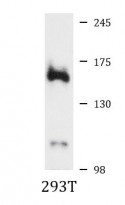ARG58740
anti-FLII antibody
anti-FLII antibody for IHC-Formalin-fixed paraffin-embedded sections,Western blot and Human,Mouse,Rat
Overview
| Product Description | Rabbit Polyclonal antibody recognizes FLII |
|---|---|
| Tested Reactivity | Hu, Ms, Rat |
| Tested Application | IHC-P, WB |
| Host | Rabbit |
| Clonality | Polyclonal |
| Isotype | IgG |
| Target Name | FLII |
| Antigen Species | Human |
| Immunogen | Recombinant fusion protein corresponding to aa. 400-660 of Human FLII (NP_002009.1). |
| Conjugation | Un-conjugated |
| Alternate Names | FLI; FLIL; Fli1; Protein flightless-1 homolog |
Application Instructions
| Application Suggestion |
|
||||||
|---|---|---|---|---|---|---|---|
| Application Note | * The dilutions indicate recommended starting dilutions and the optimal dilutions or concentrations should be determined by the scientist. | ||||||
| Positive Control | 293T | ||||||
| Observed Size | 160 kDa |
Properties
| Form | Liquid |
|---|---|
| Purification | Affinity purified. |
| Buffer | PBS (pH 7.3), 0.02% Sodium azide and 50% Glycerol. |
| Preservative | 0.02% Sodium azide |
| Stabilizer | 50% Glycerol |
| Storage Instruction | For continuous use, store undiluted antibody at 2-8°C for up to a week. For long-term storage, aliquot and store at -20°C. Storage in frost free freezers is not recommended. Avoid repeated freeze/thaw cycles. Suggest spin the vial prior to opening. The antibody solution should be gently mixed before use. |
| Note | For laboratory research only, not for drug, diagnostic or other use. |
Bioinformation
| Database Links | |
|---|---|
| Gene Symbol | FLII |
| Gene Full Name | flightless I actin binding protein |
| Background | This gene encodes a protein with a gelsolin-like actin binding domain and an N-terminal leucine-rich repeat-protein protein interaction domain. The protein is similar to a Drosophila protein involved in early embryogenesis and the structural organization of indirect flight muscle. The gene is located within the Smith-Magenis syndrome region on chromosome 17. [provided by RefSeq, Jul 2008] |
| Function | May play a role as coactivator in transcriptional activation by hormone-activated nuclear receptors (NR) and acts in cooperation with NCOA2 and CARM1. Involved in estrogen hormone signaling. Involved in early embryonic development (By similarity). May play a role in regulation of cytoskeletal rearrangements involved in cytokinesis and cell migration, by inhibiting Rac1-dependent paxillin phosphorylation. [UniProt] |
| Cellular Localization | Cell junction, Cytoplasm, Nucleus, centrosome, cytoskeleton, focal adhesion, microtubule organizing center. [UniProt] |
| Calculated MW | 145 kDa |
Images (1) Click the Picture to Zoom In






